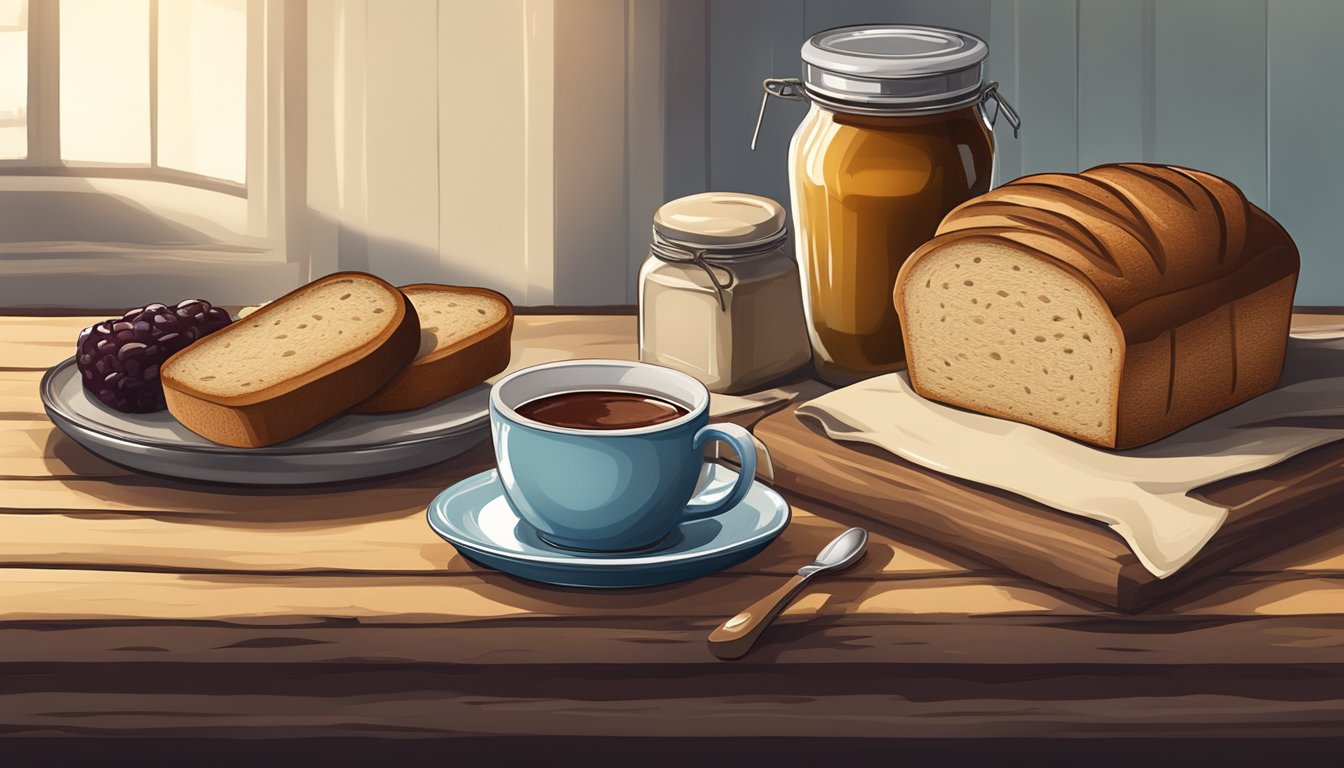Breakfast rye bread offers a hearty and nutritious start to the day. This flavorful loaf combines the rich, tangy taste of rye with a dense, satisfying texture that pairs perfectly with morning spreads and toppings.
Crafting the perfect breakfast rye requires careful attention to hydration levels, typically ranging from 65% to 85%. A higher hydration percentage yields a lighter, airier loaf, while lower hydration produces a denser crumb. Bakers can adjust the water content to achieve their desired texture and mouthfeel.
The baking process plays a crucial role in developing the signature crust and flavor of breakfast rye. Preheating the oven to 450°F (230°C) and scoring the loaf before baking allows for proper steam release and even browning. The result is a golden-brown exterior that encases a moist, flavorful interior ready to be sliced and savored.
Understanding Rye Bread

Rye bread is a complex and flavorful staple with unique characteristics. Its distinct taste and texture come from the interplay of rye flour, fermentation processes, and baking techniques.
Rye Flour and Its Varieties
Rye flour forms the foundation of rye bread. Dark rye flour contains the entire rye kernel, offering a robust flavor and dense texture. Light rye flour has the bran and germ removed, resulting in a milder taste.
Whole grain rye flour retains all parts of the kernel, providing maximum nutritional benefits. White rye flour is the most refined, with a subtle flavor profile.
Bakers often combine rye flour with wheat flour to achieve desired textures. All-purpose or bread flour can be mixed with rye to improve rise and structure.
The Science of Sourdough
Sourdough is crucial in rye bread production. It contains wild yeast and lactic acid bacteria, which contribute to flavor development and leavening.
The acidic environment created by sourdough helps break down rye proteins and starches. This process improves texture and extends shelf life.
Lactic acid bacteria produce compounds that enhance the bread’s aroma and taste. They also contribute to the characteristic tangy flavor of rye bread.
Importance of Fermentation
Fermentation is key to developing rye bread’s complex flavors. During this process, enzymes break down complex carbohydrates into simpler sugars.
Long fermentation times allow for greater flavor development. This extended period also improves the bread’s digestibility and nutritional value.
Rye doughs typically require higher hydration levels, ranging from 65% to 85%. Higher hydration contributes to a lighter, airier loaf.
Baking with Whole Grain and White Flour
Combining whole grain rye flour with white flour creates a balanced bread. Whole grain adds flavor, texture, and nutrients, while white flour improves structure.
The ratio of whole grain to white flour affects the bread’s density and taste. More whole grain results in a denser, more flavorful loaf.
Bakers often use a mix of flours to achieve desired characteristics. This blend can include rye, wheat, and sometimes other grains for added complexity.
Proper scoring of the dough before baking allows for controlled expansion during baking. This technique helps achieve an attractive appearance and optimal texture.
Crafting the Perfect Sourdough Starter

A thriving sourdough starter is the foundation for delicious rye bread. This living culture of wild yeast and bacteria transforms flour and water into a powerful leavening agent.
Caring for Your Starter
Begin by mixing 50g rye flour and 50g water in a clean glass jar. Stir thoroughly to form a smooth paste. Leave this mixture at room temperature for 24 hours. Feed your starter daily with equal parts rye flour and water, discarding half before each feeding.
Look for bubbles and a sour smell as signs of fermentation. After 5-7 days, your starter should double in size within 4-8 hours of feeding. This indicates it’s ready to use.
Store your mature starter in the refrigerator, feeding it weekly. Before baking, refresh it by feeding twice at room temperature.
The Role of Hydration
Hydration refers to the ratio of water to flour in your starter. A 100% hydration starter contains equal weights of flour and water.
Higher hydration (more water) promotes faster fermentation and a more liquid consistency. Lower hydration results in a stiffer starter that ferments more slowly.
For rye sourdough, maintain a hydration between 100-125%. This wetter consistency works well with rye flour’s unique properties.
Adjust hydration by varying the amounts of flour and water during feedings. Consistency should be like thick pancake batter.
Utilizing Sourdough Discard
Sourdough discard is the portion of starter removed before feeding. Don’t waste it – use it in various recipes.
Add discard to pancakes, waffles, or muffins for extra flavor and nutrition. Mix it into pizza dough or flatbreads for a tangy twist.
Create crackers by spreading thin layers of discard on baking sheets, seasoning, and baking until crisp.
Freeze discard in small portions for future use. Thaw in the refrigerator before adding to recipes.
Remember, discard is still active. It will continue to ferment, so use it promptly or refrigerate to slow fermentation.
Mixing Your Rye Dough

Properly mixing rye dough is crucial for achieving the perfect texture and flavor in your breakfast rye bread. The process involves careful attention to hydration levels and the incorporation of various ingredients.
Achieving the Right Consistency
Rye dough typically requires higher hydration than wheat-based breads. Aim for a hydration level between 65% and 85%, depending on your desired outcome. For a denser crumb, use 65-75% hydration. For a lighter, airier loaf, increase to 75-85%.
Start by combining warm water with yeast and let it activate for 3-5 minutes. Mix in rye flour gradually, adding more water if needed to reach the right consistency. The dough will be stickier than wheat dough, so resist the urge to add too much flour.
Knead the dough gently for 5-7 minutes. Rye contains less gluten than wheat, so overmixing can lead to a tough loaf. The dough should be smooth but still slightly tacky to the touch.
Incorporating Additional Flavors
Rye bread offers a perfect canvas for additional flavors. Common additions include caraway seeds, which provide a traditional rye flavor, and molasses or honey for sweetness and depth.
Add 1-2 tablespoons of caraway seeds per loaf for a classic taste. For a nuttier flavor, incorporate sunflower seeds or chopped walnuts. Ground coriander can add a citrusy note.
For sweeteners, use 2-3 tablespoons of molasses or honey per loaf. These not only add flavor but also help feed the yeast, resulting in a better rise. Mix these ingredients in during the initial dough formation to ensure even distribution.
Consider adding a tablespoon of cocoa powder or instant coffee for a darker color and richer taste. Remember to adjust liquid levels slightly when adding dry ingredients to maintain the proper hydration.
Bulk Fermentation and Proofing

Bulk fermentation and proofing are crucial steps in creating delicious breakfast rye bread. These processes develop flavor and structure through careful time and temperature management.
Monitoring the Bulk Fermentation Process
Bulk fermentation begins immediately after mixing the dough. During this stage, yeast consumes sugars and produces carbon dioxide, developing the gluten network. The dough should be kept at 74-76°F (23-24°C) for optimal results.
Perform gentle stretches and folds every 30 minutes for the first 2 hours to strengthen the dough. This technique helps distribute gases evenly and improves texture.
Visual cues indicate proper fermentation:
- Increased volume (30-50%)
- Smoother surface
- Bubbles visible on the sides of the container
The process typically takes 4-4.5 hours at 78°F. Adjust time for cooler temperatures or different starter quantities.
Final Proofing before Baking
After bulk fermentation, shape the dough and begin final proofing. This step allows further flavor development and creates the bread’s final structure.
Place shaped loaves in bannetons or proofing baskets. Cover with a damp cloth to prevent drying.
Proof at room temperature for 1-2 hours, or refrigerate overnight for enhanced flavor. The dough is ready when it passes the poke test:
- Gently press with a finger
- Dough should spring back slowly
- If it springs back quickly, continue proofing
- If it doesn’t spring back, it’s overproofed
Properly proofed dough ensures optimal oven spring and crumb structure in the finished loaf.
Baking and Finishing Techniques

Proper baking and finishing techniques are crucial for achieving the perfect breakfast rye bread. These methods ensure a crispy crust, tangy flavor, and chewy texture characteristic of sourdough rye.
Scoring and Baking Your Loaf
Score your rye bread just before baking to control its expansion and create an attractive appearance. Use a sharp blade to make shallow cuts across the surface. Preheat your oven to 450°F (230°C) for optimal results. Place a Dutch oven or baking stone inside to create steam, which helps develop a crisp crust.
Bake the rye bread for 30-35 minutes with the lid on, then remove it and continue baking for 15-20 minutes until the crust is dark brown. The internal temperature should reach 205°F (96°C) when fully baked.
Cooling and Storing Bread
Allow the rye bread to cool completely on a wire rack before slicing. This process can take 2-3 hours and is essential for developing flavor and texture. Cutting into warm bread can result in a gummy interior.
Store the cooled rye bread in a paper bag or bread box at room temperature for up to 3 days. For longer storage, slice and freeze the bread for up to 3 months. Thaw frozen slices at room temperature or toast them directly from frozen.
Creative Uses for Sourdough Rye Bread

Sourdough rye bread offers versatility beyond basic toast. Its distinct flavor and hearty texture make it ideal for various culinary applications.
Classic and Innovative Sandwiches
Rye bread shines in classic deli-style sandwiches. The traditional Reuben combines corned beef, Swiss cheese, sauerkraut, and Russian dressing on toasted rye. For a vegetarian twist, swap the meat for grilled portobello mushrooms.
Pumpernickel, a dark rye variant, pairs well with smoked salmon, cream cheese, and capers. Its robust flavor complements the rich, salty toppings.
Grilled cheese enthusiasts can elevate their sandwiches using rye. The bread’s tangy notes enhance sharp cheddar or creamy brie. Adding thinly sliced apples or pears creates a sweet-savory balance.
For a modern take, try an open-faced avocado toast on rye. The bread’s nutty flavor complements the creamy avocado, especially when topped with cherry tomatoes and a sprinkle of sea salt.
Delicious Breakfast Ideas
Rye sourdough makes excellent French toast. Its density absorbs the egg mixture well, resulting in a crispy exterior and custardy interior. Serve with fresh berries and a dusting of powdered sugar for a satisfying morning meal.
Crushed rye bread can replace traditional breadcrumbs in savory breakfast dishes. Use it to coat eggs Benedict for added texture and flavor. The bread’s tanginess pairs well with hollandaise sauce.
For a quick breakfast, top toasted rye with almond butter and sliced bananas. The combination of protein, healthy fats, and complex carbohydrates provides sustained energy.
Rye bread cubes can be used in breakfast casseroles or stratas. Mix with eggs, cheese, and vegetables for a hearty, make-ahead morning dish. The bread’s sturdy texture holds up well when soaked in the egg mixture.
Troubleshooting Common Rye Bread Issues

Rye bread can present unique challenges for bakers. Identifying and resolving texture problems and addressing starter issues are key to achieving successful loaves.
Analyzing Bread Texture Problems
Dense or gummy bread often results from insufficient fermentation or improper hydration. Increase fermentation time or adjust water content to improve texture. Aim for 65-85% hydration, depending on desired crumb structure.
Collapsed loaves may indicate over-proofing or weak gluten development. Reduce proofing time and ensure thorough kneading to strengthen the gluten network. Score the dough before baking to allow for better expansion.
Dry, crumbly bread suggests insufficient moisture. Increase hydration levels and consider adding a tablespoon of oil to the dough for improved texture.
Dealing with Common Starter Issues
Inactive starters can lead to poor rise. Ensure regular feedings and maintain a warm environment (75-80°F) for optimal yeast activity. If the starter lacks vigor, discard all but a tablespoon and rebuild with fresh flour and water.
Overly acidic starters produce excessively sour bread. Feed more frequently or increase the feeding ratio to reduce acidity. A 1:2:2 (starter:flour) ratio often yields balanced results.
Mold growth indicates contamination. Discard the affected starter and begin anew, maintaining strict hygiene practices. Use clean utensils and jars, and feed regularly to prevent spoilage.
Advanced Techniques and Equipment

Mastering breakfast rye requires specialized tools and techniques. Experienced bakers can elevate their craft by utilizing advanced equipment and adapting recipes for different methods.
Adapting Recipes for a Bread Machine
Bread machines simplify the rye-making process. Adjust ingredient ratios for machine use, typically reducing yeast by 25%. Add liquids first, followed by dry ingredients, with yeast on top. Select the whole grain or rye setting if available.
For a 1.5-pound loaf, use:
- 2 cups rye flour
- 1 cup bread flour
- 1 1/4 cups water
- 1 1/2 tsp active dry yeast
- 1 tsp salt
Experiment with hydration levels between 65-85% for desired texture. Higher hydration produces airier loaves.
Exploring Different Baking Tools
Specialized tools enhance rye bread quality. A banneton basket shapes and patterns dough during proofing. Dutch ovens create steam for crispy crusts. Lame knives score dough precisely.
Essential tools include:
- Digital scale for accurate measurements
- Dough whisk for mixing sticky rye dough
- Proofing box for consistent temperatures
- Baking stone for even heat distribution
Mason jars work well for storing sourdough starters. A sturdy wooden spoon aids in hand-mixing dense rye doughs. Invest in a high-quality baking thermometer to ensure proper internal bread temperature.




